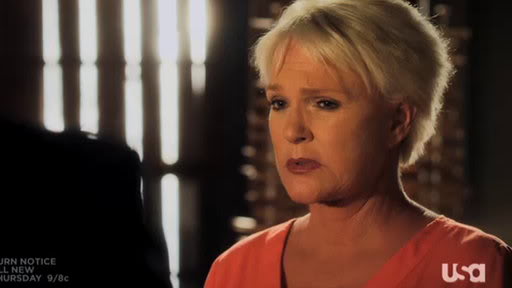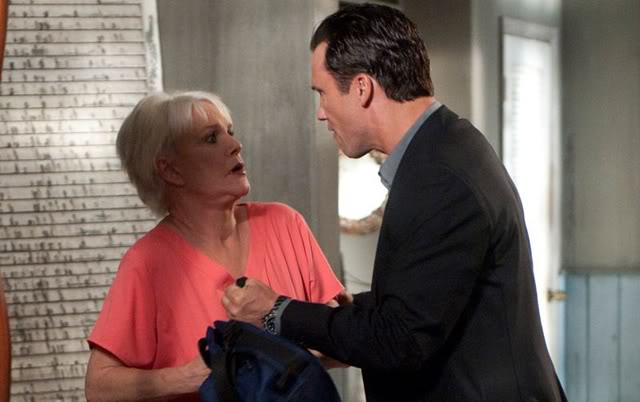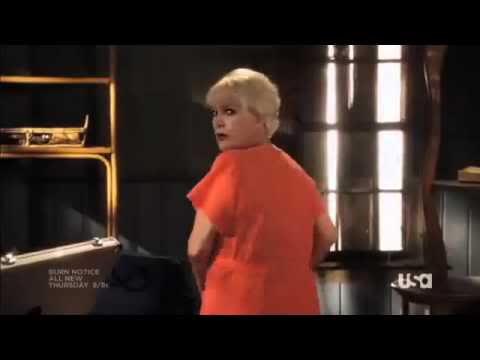An early episode in Season 5 of Burn Notice, “Bloodlines,” gives viewers a perfect example of the dictum “Show, not tell.”
Writers of all sorts (dramatic, whether stage or screen but also in prose) are frequently told “show, not tell.” The object of the “rule” is to avoid the dreaded “info dump” of exposition. It’s very easy for the storyteller to fall into mere declaration of information that he wants the audience to have. The problem is that flat exposition stalls the storytelling. Whether reading or watching, an audience member does not want the forward movement of emotional engagement to be stopped by an encyclopedia entry. And yet, for the storyteller there is an imperative to convey crucial information to the audience.
So, how do you do this?
What does “show, not tell” look like? The first thing a storyteller needs to remember is to keep the emotional thread of the story alive.
In this episode, regular viewers get a powerful unfolding of Michael’s personal backstory. From the beginning of the series, it has been clear that Michael Westen’s father had been an absuive husband and father. “Bloodlines” creates a situation where Michael, Sam, and Fiona need to get information from an injured criminal. They recruit Madeline (Michael’s mother) to pretend to be a nurse they kidnapped to tend the criminal, to give him someone sympathetic to confide in.
 To heighten the criminal’s sense of Maddie as a sympathetic figure, Michael, playing the interrogator, takes on a very harsh and brutal persona. Over the course of the series, we’ve seen him assume many different characterizations, even a few “harsh interrogators.” But this time he pulls out all the stops, enough to frighten Madeline.
To heighten the criminal’s sense of Maddie as a sympathetic figure, Michael, playing the interrogator, takes on a very harsh and brutal persona. Over the course of the series, we’ve seen him assume many different characterizations, even a few “harsh interrogators.” But this time he pulls out all the stops, enough to frighten Madeline.
 Once Madeline has had her initial encounter with the criminal, and mother and son are outside his hearing, Michael switches to attentive, concerned son. When he asks his mother if she was all right, she says yes, she just hadn’t seen “that” in a long time. Fiona, puzzled, asks, “Seen what?”
Once Madeline has had her initial encounter with the criminal, and mother and son are outside his hearing, Michael switches to attentive, concerned son. When he asks his mother if she was all right, she says yes, she just hadn’t seen “that” in a long time. Fiona, puzzled, asks, “Seen what?”
This is where “show, not tell” comes into play. In response to Fiona’s question, Madeline says “Nothing” and Michael doesn’t want to talk about it. Fiona – and the regular audience – have previously seen Michael pretend to be any number of nasty guys. To Fiona, at that moment, this current performance is just yet another one of that sort, nothing special. But the reactions of Madeline and Michael tell the audience that Michael’s performance is straight out of their personal history.
 Later, the team faces an obstacle, in that the criminal is still holding out and the clock is running down on the victims the team is trying to find. They need to get the information from the criminal. Madeline volunteers for one more session with the bad guy. Michael doesn’t like this, and angrily protests. But he is so far into the moment and the emotional current of what he has been drawing upon that he shouts at Madeline in the voice he’s been using for the “act.” At this moment, late in the story, we are finally given the explicit declaration of what is going on between Michael and Madeline. She says, “You can play your father in there, Michael, but not out here!” She then points out they need to get the information and she’s the person the bad guy is talking to.
Later, the team faces an obstacle, in that the criminal is still holding out and the clock is running down on the victims the team is trying to find. They need to get the information from the criminal. Madeline volunteers for one more session with the bad guy. Michael doesn’t like this, and angrily protests. But he is so far into the moment and the emotional current of what he has been drawing upon that he shouts at Madeline in the voice he’s been using for the “act.” At this moment, late in the story, we are finally given the explicit declaration of what is going on between Michael and Madeline. She says, “You can play your father in there, Michael, but not out here!” She then points out they need to get the information and she’s the person the bad guy is talking to.
 Madeline’s explicit statement stops Michael in his tracks, forcing him to realize how easily he can fall into the pattern of his father’s behavior. Four and a half seasons of subtext is brought to the surface in one moment: the one thing Michael does not want to be is the brutal man his father was, and it is one of the things that he can slip into almost without thinking about it.
Madeline’s explicit statement stops Michael in his tracks, forcing him to realize how easily he can fall into the pattern of his father’s behavior. Four and a half seasons of subtext is brought to the surface in one moment: the one thing Michael does not want to be is the brutal man his father was, and it is one of the things that he can slip into almost without thinking about it.
But again, Madeline’s angry retort about his behavior is the only direct reference to this information. The episode is laden with behavioral clues regarding the non-verbal exposition. What we do not get is a speech by either Madeline or Michael about how Frank Westen belittled and beat his wife.
Because we see the pain Madeline and Michael feel, because we see Michael’s shock at realizing how easily he can “become” his father, we do not need a long explanation of how the family background affects Michael’s choices to help people in need. We’ve seen it.
Of course, the visual aspect of drama gives it an advantage over prose in the “show” department. But consider how the above interactions could be described in prose. All you would need would be the dialogue actually used, and perhaps a few spare sentences referencing the painful familiarity to Michael and Madeline of the brutality, a dash of Michael’s horror at realizing how easily it comes to him, and one touch of Madeline’s strength in enduring it. In these things, a prose writer would have shown the backstory without stopping the story for a passage relating how Frank beat his wife, terrorized his son, and generally tromped on those who crossed him.
“Showing” means bringing the expositional information into the dramatic moment of your story. Your characters have feelings and reactions to the data you the writer want to get to the audience. Use the characters’ emotions to transport the exposition. If you do that, the information is much more likely to arrive and be comprehended by the audience.
